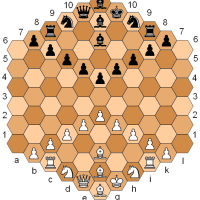
Fairy Chess
Not long ago I went into a coffee shop and saw a couple playing chess. My chess addiction winning over my caffeine addiction, I sauntered over to watch the game a bit, which was in its ending throes. The three of us were staring intently and silently at the board for a few moments, when the woman moved a pawn. Sideways.
I said nothing, wondering if I had seen correctly. I had. The man replied with a similar move. Breaking the silence I asked, "What rules are you playing by?" They laughed, slightly embarrassed. "Our own," was the answer, "our pawns move just like the kings."
They had invented a chess variant, also sometimes referred to as Fairy Chess. The latter term is also used to refer to problems posed using chess variants, and seems to have originated in the early 20th century with a connotation related to 'fanciful'.
By one authoritative account, there are over 40,000 variants of chess. Some of them vary only slightly by the way the units move; others may use different sized boards, have different capturing or other rules, or have novel pieces, which are sometimes referred to as 'fairy pieces'. There are even people who engage in chess boxing, where they alternate between mental and physical rounds. The variety is seemingly endless.
So are the names. In addition to Bughouse, which is popular in many chess classes, there are variants called Apocalypse, Machine Gun Chess (which is different from Rifle Chess), Sputnik Chess, Wildebeest Chess, Three Dimensional Chess, Earthquake Chess, Grasshopper Chess, Chitty-Chatty Chess, Pregnant Chess, Heterochess, and (so as not to discriminate by sexual preference) Gay Chess, the object of which is a Gaymate. D. B. Pritchard writes in The Encyclopedia of Chess Variants that the most played variants in the world are Xiangzi (Chinese) and Shogi (Japanese) chess.
The late Bobby Fischer invented his own chess variant called FIscherandom Chess, which is also referred to as Chess960 since there are 960 different ways that the board can be set up. I have previously written about Fischerrandom chess.
One popular variant is called Progressive Chess, whereby White plays an opening move as usual. But then Black replies with two consecutive moves, then White plays three consecutive moves and so on. Fibonacci Chess is a variant of this variant in which the consecutive moves comprise the well-known Fibonacci sequence, where each move-multiple is the sum of the two preceding move-multiples. (1, 1, 2, 3, 5, 8, 13, …)
Many chess variants have unusual boards. Some examples are Capablanca Chess, invented by the late world champion and played on an 8x10 or a 10x10 board with chancellor and an archbishop, in addition to the normal chess pieces. Here is a picture of Capa’s board, followed by pictures of boards for the games Infinite Chess and 3-Dimensional Space Chess.



One very interesting variant is Losing Chess. You win when you lose. That is, the object of the game is to have your opponent capture all of your pawns and pieces, including your King, which is capturable. Not only that, but when a capture may be made, a player is compelled to make it, which is not only reasonable, but
the game would not make sense
otherwise. When more than one capture may be made, then the capturing player is allowed to choose among the alternatives. If a stalemate position occurs then the player who is stalemated is declared the winner.
As previously mentioned, the variety of chess variants is far too great to go into much detail here, but to give you an idea of how they can differ, Michael Keller’s taxonomy of chess variants has 25 distinguishing characteristics, as follows:
- Fixed Initial Position
- Variable Initial Position
- Historical and Regional
- Modified Pawns and Promotion
- Modified Kings
- Combined Pieces
- New Pieces
- Plane Boards
- Multi-Dimensional Boards
- Non-Planar Boards
- Mosaic Boards
- Boards Modifying Movement
- Miscellaneous Board Modifications
- Multiple Moves per Turn
- Movement Limitations
- Multiple Units per Square
- New Types of Movement
- Movement of Enemy and Neutral Units
- Miscellaneous Movement Modifications
- New Methods of Capture
- Disposition of Captives
- Side Effects of Capture
- Modifications of Objective
- Modification of Number of Players
If you decide to start playing or even inventing your own chess variant, please keep one thing at the top of your mind. Choose your move carefully.
[p.s. If you missed my earlier blog, please send me your games, per instructions there, to be featured in an upcoming blog.]


